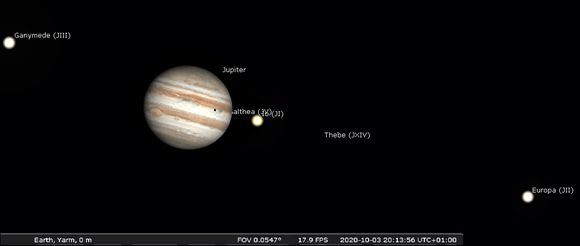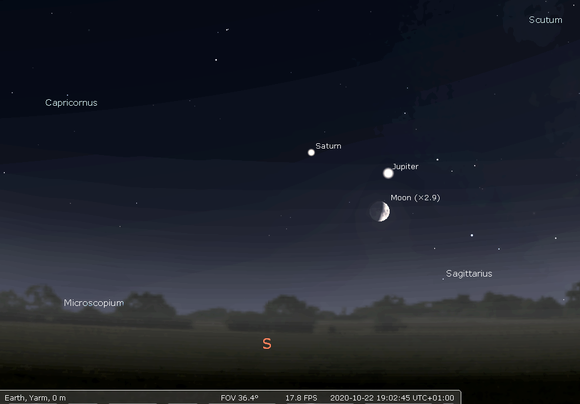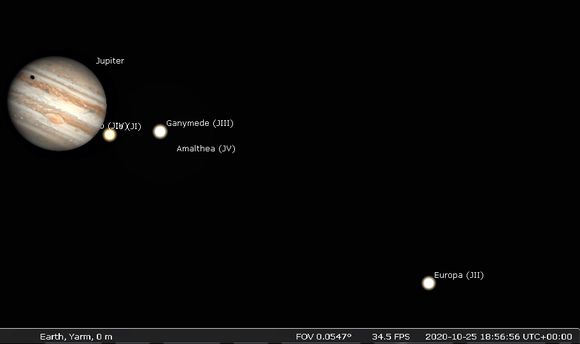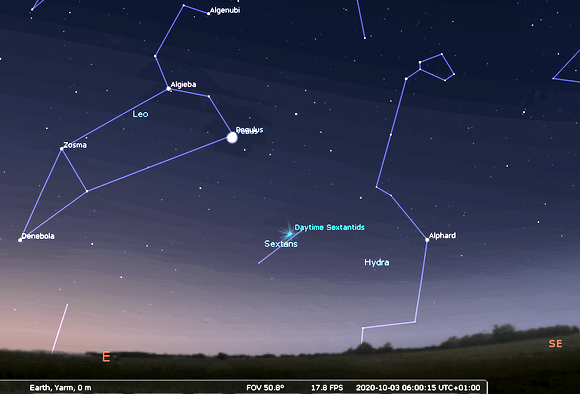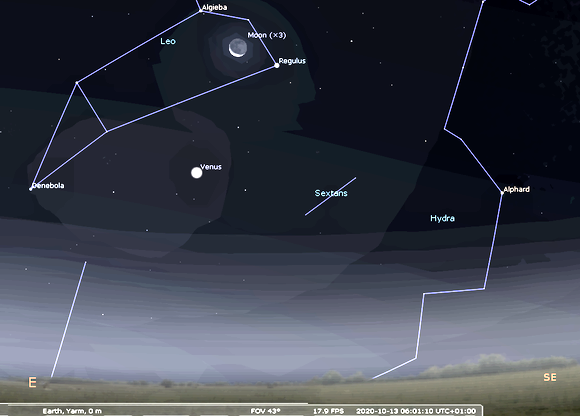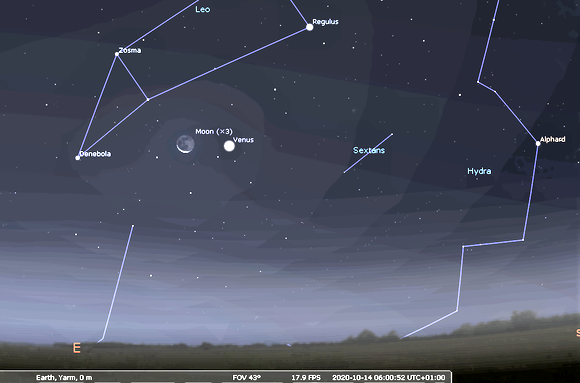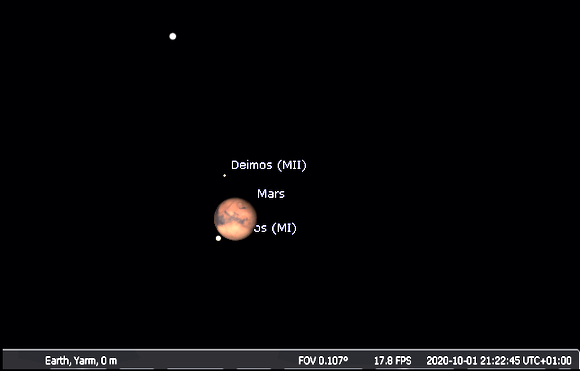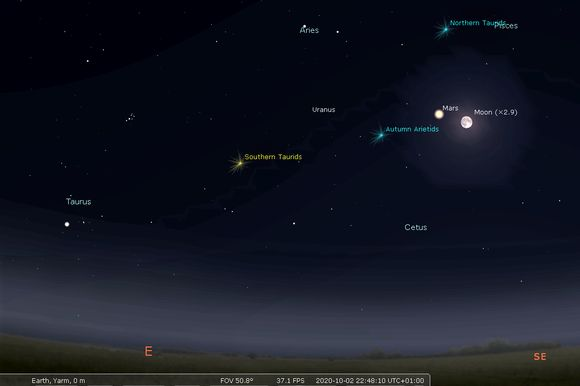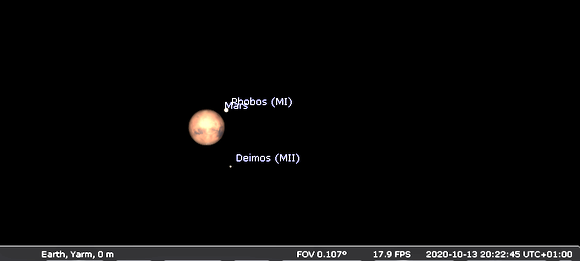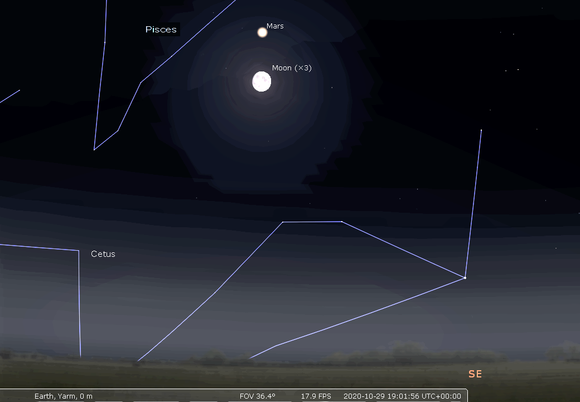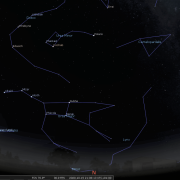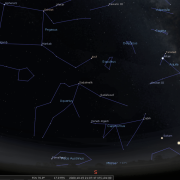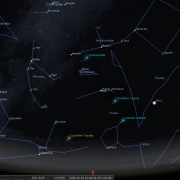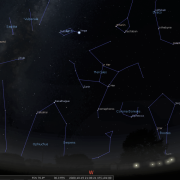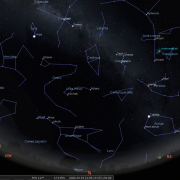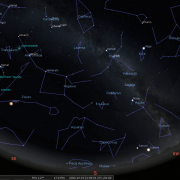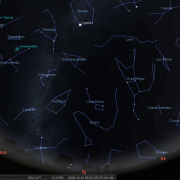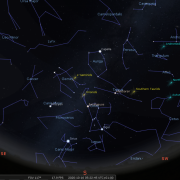Welcome to the WDAS monthly newsletter for October 2020: a digest of the month's latest contributions to our website. Below you'll find Society News: including Member photos and Sky Notes for the coming month.
Society News
Unfortunately due to a dreaded combination of fresh Covid 19 restrictions, a spike in local cases and then the wrong weather at the wrong time, the scheduled events all fell victim to these circumstances.
It's been dire to say the least as far as Star Party events are concerned, with the last one being held in February. In fact the only occasion two or more society members have met to do some observing over the summer months was to try out Keith's Eviscope, and even then the sky conditions were far from ideal. The chances of a public 'comet' watch, even passed us by. Then again, decent comets always seem to bring trouble with them!. Safe to say, it has been most frustrating since Covid 19 'road into town' and trashed the place. It has been far worse for others though, we have just been inconvenienced.
Although by no means out of the Covid woods (just lost in them), we do intend to hold some 'Mars party' events in October and, hopefully November (see Mars Observation evenings).
As for our annual summer star party assessment, i think that would be stamped 'abject failure', however in accordance with government policy we left the Star Party assessment calculation to 'a world beating algorithm'. Apparently, so it said, we had a fantastic summer with successful events at least 3 times a week. Well done all! To summarise then, Aaaaaahhhhhh.
It is looking increasingly unlikely there will be a society meeting this October, or for that matter probably November. As of going to press meetings of six or more people are prohibited, more places are in some form of local lockdown scenario and the College is understandably curtailing 'evening classes' etc anyway. We are planning some select Mars observing nights at the Bruce Observatory in October and November (see Mars Observing Evenings), but there are no other scheduled public star party events planned.
Covid 19 looks as though it's here for the immediate foreseeable future, with the possibility of further prohibitive measures being introduced by the government. So, unfortunately the October meeting will have to be cancelled and we shall review matters for November nearer the time.
The nature of this pandemic and hence government responses are rather fluid..... and circumstances can change rapidly, but prospects do look pretty bleak for any full blown meetings or public events without current restrictions or safety measures in place until well into the New Year. But we shall see.
Sky Notes
In this month's Sky Notes:
Planetary Skylights

 Jupiter and Saturn continue their slow march above the southern horizon, located in Sagittarius to the left of the 'teapot' asterism. As soon as darkness falls at the start of October they are only just crossing the south meridian and hence at their highest and well placed for observation. This is however still rather low from UK shores and 'seeing' is often unstable, so allow time at the eyepiece. Jupiter will be setting by 23:00h in early October and shortly after 20:00h by the end of the month. Saturn will follow approximately 45 minutes later.
Jupiter and Saturn continue their slow march above the southern horizon, located in Sagittarius to the left of the 'teapot' asterism. As soon as darkness falls at the start of October they are only just crossing the south meridian and hence at their highest and well placed for observation. This is however still rather low from UK shores and 'seeing' is often unstable, so allow time at the eyepiece. Jupiter will be setting by 23:00h in early October and shortly after 20:00h by the end of the month. Saturn will follow approximately 45 minutes later.
When seeing is decent, both planets will be worth scrutinising through the eyepiece of a telescope throughout October, offering up plenty of detail. Look for the banding across Jupiter’s disk, the Great Red Spot (GRS) and daily motion of the Galilean moons. Saturn of course has the stunning ring system. The waxing moon resides below Jupiter and Saturn on the 22nd.
Jupiter GRS and Galilean moon shadow transit visibility:
-
1st - GRS visible 19:30-20:30h BST
-
3rd - GRS visible before 19:30-22:00h Io visible from 19:15-20:45h BST
-
5th GRS from 21:00-22:00h BST
-
6th Europa Sh Tr from 21:45-22:30h BST
-
7th GRS from 21:45h BST
-
8th GRS from 19:00-21:00h BST
-
10th GRS and Io sh tr around 21:00h BST
-
12th GRS from 21:00h BST
-
13th GRS 19:00-20:00h BST
-
15th GRS from 19:00-21:00h BST
-
17th GRS and Callisto sh tr around 21:00h BST
-
18th GRS from 18:45h and Ganymede sh tr
-
19th Io shadow 18:45h BST
-
20th GRS from 18:45h BST
-
22nd GRS 7:30 - 21:30h BST
-
24th Io Sh Tr from 18:15-18:55h BST
-
25th GRS from 17:30-19:30h Ganymede Sh tr from 18:45h GMT
-
27th GRS from 18:00-20:00h GMT
-
30th GRS from 16:00-19:00h GMT
- 31st Europa Sh tr from 18:00-20:00h GMT.
15-Oct-2020 at 21:15h (S): Jupiter with (L to R) Ganymede, Io's shadow), Europa
(Click for full-sized image)
 Uranus becomes the last of the gas giant planets to reach opposition this year, on the very last day of October! Although not a naked eye object for the majority of people, at Mag +5.7 Uranus is visible to keen sighted observers viewing from dark locations ( but you need to know exactly where to look). On opposition night itself a nearby full moon will drown Uranus out, so wait for a no moon period to try this. Uranus resides just within the borders of Aries, approximately 10 degrees below the ‘crooked line’ asterism of the Ram marked by Hamal and Sheratan. It can be located just over a degree west of the faint 6th Mag star 29 Ari. Through binoculars Uranus resembles a rather faint star of subtle grey/green hue. You will require a telescope (modest size upwards) to discern its tiny disk
Uranus becomes the last of the gas giant planets to reach opposition this year, on the very last day of October! Although not a naked eye object for the majority of people, at Mag +5.7 Uranus is visible to keen sighted observers viewing from dark locations ( but you need to know exactly where to look). On opposition night itself a nearby full moon will drown Uranus out, so wait for a no moon period to try this. Uranus resides just within the borders of Aries, approximately 10 degrees below the ‘crooked line’ asterism of the Ram marked by Hamal and Sheratan. It can be located just over a degree west of the faint 6th Mag star 29 Ari. Through binoculars Uranus resembles a rather faint star of subtle grey/green hue. You will require a telescope (modest size upwards) to discern its tiny disk
 Neptune resides in the constellation of Aquarius, just over 2 degrees Northeast of the star Phi aqr (Mag +4.2), whilst 96 aqr. (Mag+5.5) lies 42 arc minutes to the WNW of it. At a distance of 2.67 million miles, you will require a telescope to spot the diminutive disk, which has a blue/grey hue. Binoculars show it as a speck only.
Neptune resides in the constellation of Aquarius, just over 2 degrees Northeast of the star Phi aqr (Mag +4.2), whilst 96 aqr. (Mag+5.5) lies 42 arc minutes to the WNW of it. At a distance of 2.67 million miles, you will require a telescope to spot the diminutive disk, which has a blue/grey hue. Binoculars show it as a speck only.
 Venus spends the month moving down through Leo, passing below the ‘sickle asterism’. At the start of the month Venus has a very close encounter with the chief star in Leo- Regulus. View on the morning of the 3rd around 06:00h when they are separated by just over 15 arc minutes (a quarter of a degree). Regulus (Mag +1.4) will be totally overwhelmed by Venus at Mag -4.1. A waning crescent moon sits to the left of Venus on the 14th.
Venus spends the month moving down through Leo, passing below the ‘sickle asterism’. At the start of the month Venus has a very close encounter with the chief star in Leo- Regulus. View on the morning of the 3rd around 06:00h when they are separated by just over 15 arc minutes (a quarter of a degree). Regulus (Mag +1.4) will be totally overwhelmed by Venus at Mag -4.1. A waning crescent moon sits to the left of Venus on the 14th.
Observing Venus just became rather more meaningful, now that signs of microbial life appear to exist in the upper layers of its cloud atmosphere. Who would have thought that? This offers up the exciting possibility of life forms existing on, or, around certain other planets or moons where hitherto it was assumed conditions would be too extreme. It may be that for life to arise all that is required are conditions that are within certain tolerances to support that type of life, wherever they exist at the planet.

 Finally, there are two full Moons this month – one on the first day, the other on the last. The second full moon is commonly known as a Blue Moon – it won’t appear blue of course, however werewolves will be having a 'Waaaaaaail' of a time! Sorry couldn’t resist.
Finally, there are two full Moons this month – one on the first day, the other on the last. The second full moon is commonly known as a Blue Moon – it won’t appear blue of course, however werewolves will be having a 'Waaaaaaail' of a time! Sorry couldn’t resist.
Mars Opposition 2020
After an interval of over 22 months Mars finally arrives at opposition this month, the most favourable for UK observers until 2035. Certainly for astronomers in mid northern hemisphere locations, it is the best viewing prospects for a generation. True, Mars was closer in 2003 and again in 2018, but was located much lower in the sky then where seeing is compromised. For the 2020 opposition Mars will be in the constellation of Pisces, substantially higher in the sky and in terms of size and brightness will only be marginally less inferior than 2018.
As we head into October Mars will be visible due east by 20:00h (BST), an unmistakeable fiery presence with a magnitude of -2.6, easily surpassing that of Jupiter. The red planet will brighten a tad more by opposition date on Oct 13th to -2.62. Careful observation will reveal that Mars spends October in retrograde motion, ie moving back westwards through the ‘ribbon’ of Pisces, before returning to pro-grade motion by mid November.
When a planet reaches opposition (Mars and the rest of the planets beyond it), it lies opposite the Sun in the sky, rising as the sun sets and setting as the sun rises. Although reaching opposition on the 13th, Mars appears largest in the eyepiece a week beforehand on October 6th when it is actually closest to Earth, just a smidge over 38 million miles away. It will then appear 22.6 arc seconds across, more than double the size it was in early July. This will have diminished only slightly by the start of November, so there is a good month in which to scrutinise the surface of the red planet, and it is the surface not an atmosphere we are gazing at.
When viewing Mars, binoculars won’t reveal much more other than a pinkish-orange disk. You will require a telescope of at least 3 inch or 75mm in order to pick up detail and changes to Mars’s appearance in the run up to opposition and beyond. Even at a good opposition the Martian disk is not large, only half the size of Jupiter’s, which is much more distant, and if seeing is poor it’s not uncommon to see a pinkish blurry blob, so give yourself time at the eyepiece. When seeing is respectable, as it should be this year with Mars riding higher across the south, magnifications of between 75x to 100x for a typical 4-inch scope, should be possible. It is rarely viable to use more than 50x per inch of aperture from our shores.
For this opposition, Mars’s southern hemisphere and polar cap are tilted towards us, but the cap will appear small due to the extra warming Mars received when closest to the Sun in its orbit, causing the cap to shrink. Apart from the bright southern polar cap, areas of light and dark, representing deserts and exposed rock should be apparent. The most prominent dark feature is the V-shaped form of Syrtis Major, a low-level shield volcano which will be rotated into view during the first week of Octobe. Between the southern boundary of Syrtis Major and the southern polar cap lies the Hellas Basin, a 2,300km diameter basin and one of the largest impact craters in the Solar System. Hellas can sometimes appear bright due to clouds that form in the basin. Other features to look for are Mare Sirenum and the large Martian volcanoes, including Olympus Mons – the largest in the solar system. The 3rd week in October is the best time to view these. By the 4th week of October the Valles Marineris- the Martian ‘grand canyon’ will be rotated in to view. By the last week of October the dark area's of Protei Regio and Sinus Meridiani will be prominent as well as the small, pale, Argyre basin.
Often when Mars is near opposition dust storms arise on the surface, usually fairly small, appearing as lighter patches, yellowish in colour. Occasionally these can grow into regional or even planet wide dust events, obscuring the surface for weeks. Should this happen i'm afraid you won't see anything other than a pink/orange ball! The moon resides close to Mars on the 3rd and again on the 30th. Let's hope for decent clear skies on Earth, that and no dust storms on Mars! See also Mars Observing Evenings.
13-Oct-2020 at 20:30h (SE): Mars with moons Phobos (above) and Deimos (below) on opposition night. A telescope of aperture 4" (100mm) will be required to spot the moons.
(Click for full-sized image)
Meteors

The Orionids (Oct 16- 27) are the months most reliable shower, peaking this year on Oct 21/22. Prospects are pretty good again year, with the moon heading towards first quarter and out of the way by 20:30h. A peak rate of 20-25 in ideal conditions is possible; however expect a realistic observational rate of around 15 per hour in the early morning hours.
Along with the May Eta Aquarids, Orionids are associated with Comet Halley, but are more favourable for northern hemisphere observers due to the radiant being situated high in the S by early morning hours. Orionids are swift moving, often producing persistent trains.
The Southern Taurids peak on the 10th, however rates will be little more than sporadic levels (5 per hour) and there will some interference from a last quarter moon.
The weak Piscid shower has three peak dates, Oct 13th normally the being the optimum one. Observed rates are little better than sporadic levels - around 3-7 per hour. Piscid meteors are often slow, of long duration, but not very brilliant. There will be very little moonlight to hamper viewing though.
Perhaps the most interesting shower is the Giacobinids or Draconids (Oct 6 -10th peaking on the 8th) which are associated with the periodic comet Giacabini-Zinner (6yrs) The shower is very erratic, but can produce outbursts of activity. Observing over the night of the 8th, rates up to 15 per hour are possible in the early morning hours, but a last quarter moon will hamper observations a little. The Draconids are associated with the constellation of Draco, which is located high up in the NW winding its way between the two celestial bears of Ursa Major and Minor.
Additional Image Credits:
- Planets and Comets where not otherwise mentioned: NASA
- Sky Charts: Stellarium Software
With Mars reaching a very favourable opposition for UK observers this October, it would be rather a shame and missed opportunity not to host a few Mars observing sessions at the Bruce Observatory at Caedmon College. Matters may change, preventing any mixing of people outside household bubbles, but as of Sept 29th it would be possible to have limited numbers, say no more than 5 people at a time, at the Bruce Observatory. We will have to wait for Mars to ‘clear the trees’ at the College, so probably dates later in the month would be more practical.
If you would like to view the 'Red Planet' through the Cooke refractor at the Observatory we are proposing to hold Mars observing evenings on Oct 17th, 24th ( 9-10pm) and Oct 31st (8:30-10pm).
Each time period will be split into 'half hour' time slots and we are asking people to book a time slot for the particular evening. Two time slots for the first two dates and three for the last date. This can be done by emailing Mark;- spanton33![]() talktalk.net. The October dates will be reserved for society members initially.
talktalk.net. The October dates will be reserved for society members initially.
Please be aware there will be no toilet facilites available on site, sorry.
Should restrictions still allow small gatherings, dates for November, will be set aside for public viewings to tie in with National Astronomy week (Nov 14-22). The dates in November are 7th, 14th and 21st. Times are from 7pm - 9:30pm, again with 30 minute time slot periods bookable as before, the last time slot being from 9pm.
Of course everything is dependant on the weather conditions on the evening in question and a degree of furtune ...or not, will dictate just who sees what. We will try to accommodate and reschedule those 'clouded out or rained off' nights.
Covid 19 safety measures and protocols will be employed. Strickly first come first serve.
Events
 Observe the night sky with us at the Bruce Observatory, Whitby School
Observe the night sky with us at the Bruce Observatory, Whitby School
Observing Nights are held weather permitting: check for a relatively clear sky before leaving home. If in doubt, Mark can be reached on 07886069339
Please note the college drive gate is now operated via a electronic key code - so anyone wishing to attend must be at the car park at the top of the drive by 19:00hrs - unless an arrival time has been arranged with Mark/Keith.
 Whitby School - Room H1.
Whitby School - Room H1.
In Members' monthly meetings we usually take a tour of the night sky for the coming month using the Planetarium program. Have talks and presentations on various topics of astronomy/space etc, and discuss future events etc. New members welcome.

